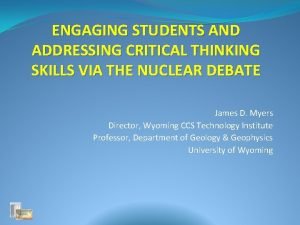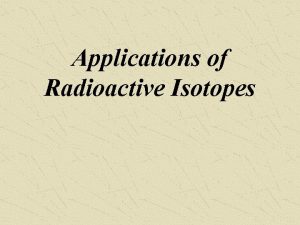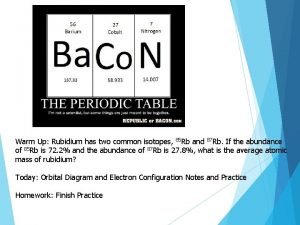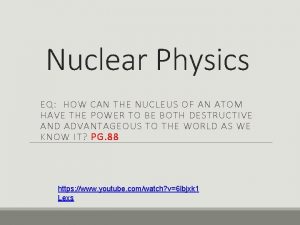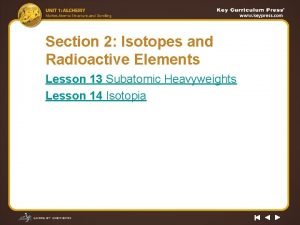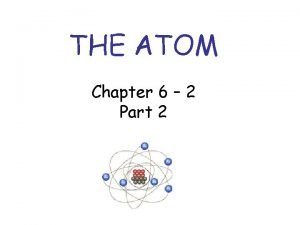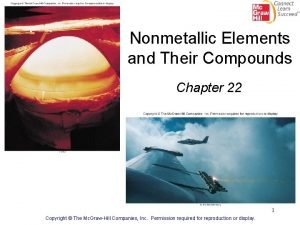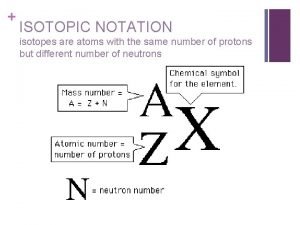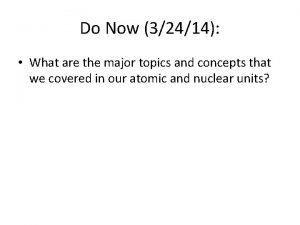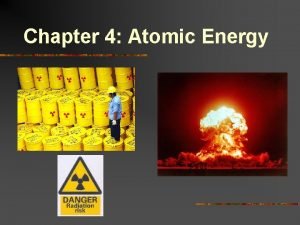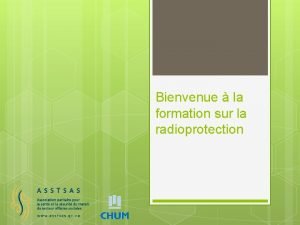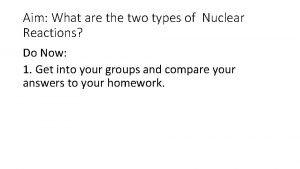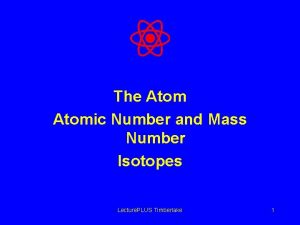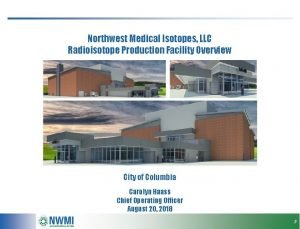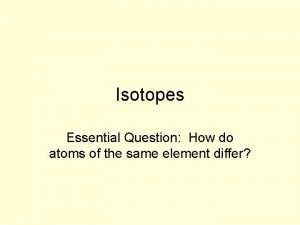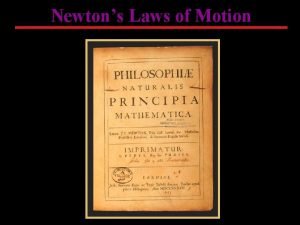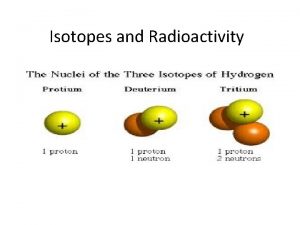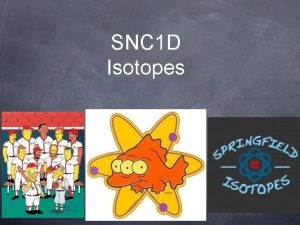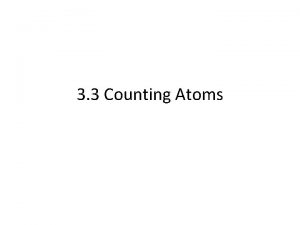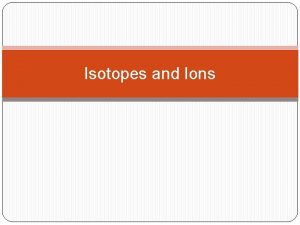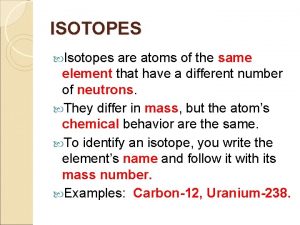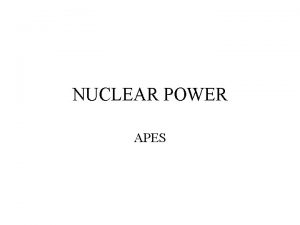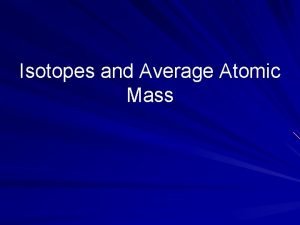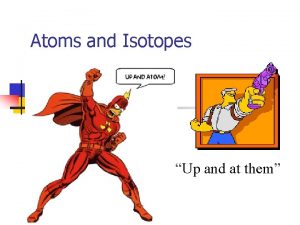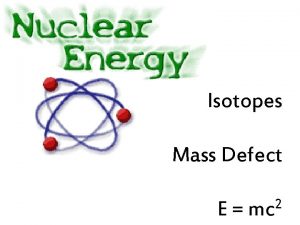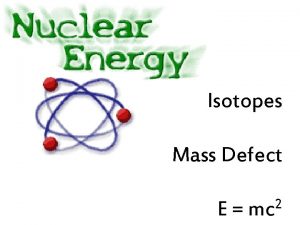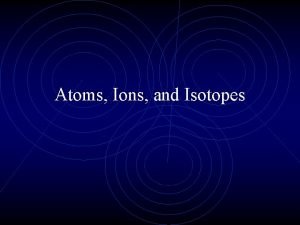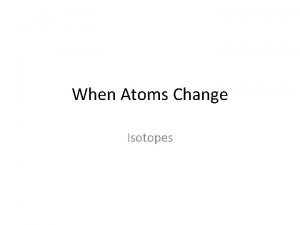Mass Spectrographs and Isotopes Isotopes are atoms of




































- Slides: 36

Mass Spectrographs and Isotopes

Isotopes are atoms of the same kind (same number of protons – same atomic number) which differ in their atomic masses (have different numbers of neutrons in their nuclei).

Representing Isotopes : Symbols and Names Symbols for isotopes are written with the atomic number (# protons) at the lower left corner of the Atom’s symbol and the atomic mass (# protons and neutrons) at the upper left corner of the symbol. The name of the isotope is typically written with the element’s name followed by its hyphenated atomic mass. Lithium-7

Einstein: Mass and Energy Relationship Albert Einstein predicted that mass can be converted into energy and energy can be converted into mass by the relationship, E = mc 2. E represents energy in joules, m is mass in kg and c 2 is the speed of light squared (9 x 1016 m 2/s 2). A small mass converts into much energy due to c 2.

Verification of Einstein Theory The truth of E = mc 2 has been confirmed experimentally. Energy particles of light have been observed to form positrons (positive electrons) and electrons, while colliding positrons and electrons annihilate each other forming light photons. Positrons are rare in our universe.

Mass/Energy Conversion Relatively Rare on Earth The conversion of energy into mass and mass into energy is not a common occurrence on Earth since it happens only in atomic fusion and fission and in a few other processes. The vast majority of chemical processes involve no conversion between mass and energy.

Forming Atomic Nuclei: Mass Defect Experiments show that the mass of the protons and neutrons bound together in a formed nucleus is always less than the mass of the same number of protons and neutrons not yet bound together. The mass that protons and neutrons lose when they bind together into a nucleus is called the mass defect.

Nuclear Formation: Energy Loss When separate protons and neutrons bind together to form a nucleus, the mass they lose is given off as energy by Einstein’s relation E= mc 2. Combined nuclei are more stable than separate protons and neutrons because they give off energy and therefore have a lower energy value.

Binding Energy To separate the protons and neutrons in a nucleus, much energy has to be used to pry them apart. The amount of energy needed to separate nuclear particles is called the binding energy of the nucleus. The binding energy is equal to the energy produced from the mass defect (mass loss) when separate nuclear particles bind together to form a nucleus. The energy from the mass defect is obtained from E = mc 2.

A Sample Problem

Binding Energy Versus Atomic Number As the atomic number of an atom increases, the binding energy per nucleon (per nuclear particle - proton or neutron) increases up to iron (Fe – atomic number 26). After Fe, the binding energy per nucleon drops.

Atomic Fusion – Star Power Gravity force pulling a nebula into a compact ball raises the temperature (120, 000 o. C) of the nebula to a point where atomic fusion begins. At fusion temperatures, positive nuclei are forced to come close enough to each other to allow the strong nuclear force (which only attracts within one nuclear radius) to pull the separate nuclei together into a single nucleus, thereby releasing the energy from the mass defect. The energy stars give off is from the fusion processes occurring within the stars. Nebula warmed through gravity collapse Nebula Fusion starts and a star is born

Atomic Fusion – Star Power The energy stars give off is from the fusion processes occurring within the stars, driven by extreme temperatures which force nuclei close enough to be captured by the strong nuclear force.

Stars Create New Elements Fusion in stars creates larger and larger nuclei which sink to the interior of the star due to their greater mass and density. All the elements of nature (other than hydrogen) are thought to have been formed by fusion processes in stars.

Stability of Atomic Nuclei As an atom’s nucleus gets larger, the amount of protons increases. This causes the repulsive forces to grow in a nucleus which would tend to break apart a nucleus. Adding more neutrons to large nuclei separates the repulsing protons from each other, stabilizing larger nuclei.

Neutrons Reduce Proton Repulsion In larger nuclei, adding neutrons brings more stability since repulsive proton forces are reduced by neutrons separating protons from protons. (Z and N reversed on this chart. )

Isotope Stability and Decay Modes As the number of nucleons (protons and neutrons) in a nucleus grows, more neutrons are needed per given number of protons to make the nucleus stable. Elements with an excess of neutrons undergo beta decay while elements with a neutron deficit undergo positron decay. Heavier nuclei with a neutron deficit undergo alpha decay.

Beta Decay Processes Beta minus decay converts a neutron into a proton, releasing an electron and an electron antineutrino. Beta plus decay converts a proton into a neutron, releasing a positron (positive electron) and a neutrino.

Beta Minus Animation Nucleus undergoing beta decay: Neutron changing into proton inside the nucleus (particles shot out of the nucleus)

Neutrons and Protons: Made up of Quarks Neutrons and protons are particles called baryons. A baryon is made up of 3 particles called quarks. There are six kinds of quarks, each having a fractional charge in relation to the charge of a proton. The most common baryons are neutrons and protons. Protons are made up of two up and one down quark (+2/3 + 2/3 – 1/3 = +1) while neutrons are made up of two down and one up quark (-1/3 + 2/3 = 0).

Beta Decay: Changing A Quark In beta decay, the weak nuclear force mediates a change of one quark into another. In beta plus decay, an up quark is converted into a down quark while in beta minus decay, a down quark is converted into an up quark.

Stability Obtained by Beta- and Beta+ Decay Elements with too many neutrons/protons tend to decay by beta minus while elements with too few neutrons/protons tend to decay by beta plus or positron decay. Beta C-14 - Decay N-14 C-13 Increasing neutron number C-12 B-11 Stable Isotope C-11 Beta + decay Increasing proton number

Positron Electron Annihilation A positive electron (positron) is attracted to an electron and the two particles annihilate into two photons of gamma ray energy. Positrons are more rare in our universe which is dominated by electrons, protons and neutrons. Any positron generated by decay is quickly annihilated by the relative excess of electrons.

Alpha Decay Process In alpha decay, an atom releases an alpha particle (helium nucleus made up of 2 protons and 2 neutrons). This process produces a new element that is closer to the stable isotopes in the previous graphs.

Instability of Very Large Nuclei Very large nuclei like in uranium atoms tend to be unstable due to two factors. They have increasing repulsive forces in their nuclei due to their large numbers of protons and their binding force per nucleon (proton or neutron) is declining. Uranium nuclei have just enough binding energy to keep the repulsive forces from breaking the nucleus apart.

Upsetting the Balance of a Uranium Nucleus Adding one neutron to a uranium nucleus reduces the binding energy per nucleon so that now the binding force is less than the repulsive forces per nucleon. This causes the nucleus to break apart – atomic fission.

Energy From Fission and Fusion The energy released from fission and fusion comes from mass loss. Fission produces less energy than fusion.

Comparing Fusion and Fission Lighter atomic nuclei can fuse if high temperatures force them within a distance of a radius, allowing the strong nuclear force to bind them together. Heavier atomic nuclei can fission (split) if a particle is added that reduces the binding energy per nucleon and/or increases the repulsive force. Fission produces less energy than fusion. Both processes produce energy by converting energy from mass by E=mc 2.

Separating Isotopes The mass spectrograph is an instrument that separates mixtures of isotopes or other charged particles. It was invented and worked on by Francis Aston from 1925 -1937. Aston won a Nobel Prize for discovering isotopes with it.

How A Mass Spectrograph Works An element sample is injected and heated to a vapour. An electron source gives the gaseous atoms a charge. The charged ions are accelerated by an electric field and then are passed into a magnetic field. The magnetic field separates the moving ions by their mass into a series of bands.

The Spectrograph’s Separating Principle Moving balls in a wind are deflected on the basis of their mass with lighter balls deflecting more. Likewise in a magnetic field, moving particles (each having its own magnetic field repelling the outside magnetic field) are deflected more if they are lighter. External Magnetic Field wind Less massive, more deflection Moving Objects Moving Ions

Isotopic Separation by a Magnetic Field The heavier isotopes deflect the least while the lighter isotopes deflect the most.

Determining Isotope Abundance Mass Spectrograph detectors record the number of isotopes hitting the detector as separate bands. When photographic film is used, a larger band width represents a larger fraction of that isotope. The % abundance is the isotopic band width divided by the sum of all the band widths. Isotope bands for magnesium Mg-24 78. 99 % Mg-25 10. 00 % Mg-26 11. 01%

Another Representation of Isotopic Abundance Sensors can display intensities of separated isotopes as a percent of the total intensity to give a reading of relative abundance of each isotope.

End of Presentation

A A
 Antigentest åre
Antigentest åre Isotopes pogil
Isotopes pogil At stp which substance is the best conductor of electricity
At stp which substance is the best conductor of electricity What is
What is Is atomic mass and relative atomic mass the same
Is atomic mass and relative atomic mass the same Difference between atomic number and atomic mass
Difference between atomic number and atomic mass Difference between atomic mass and mass number
Difference between atomic mass and mass number How to write atomic number and mass number
How to write atomic number and mass number Fertile isotopes
Fertile isotopes Calculating the average atomic mass
Calculating the average atomic mass Atomic isotopes
Atomic isotopes Uses of radioactive isotopes
Uses of radioactive isotopes Noble gas notation for rubidium
Noble gas notation for rubidium Uses of radioactive isotopes in agriculture
Uses of radioactive isotopes in agriculture Write the hyphen notation of the three isotopes of hydrogen
Write the hyphen notation of the three isotopes of hydrogen How to write atomic number and mass number
How to write atomic number and mass number Lesson 13 subatomic heavyweights isotopes
Lesson 13 subatomic heavyweights isotopes Isotopes
Isotopes Properties of isotopes
Properties of isotopes Hydrogen isotopes
Hydrogen isotopes Isotopic notation
Isotopic notation Hydrogen isotopes
Hydrogen isotopes Isotopes
Isotopes Isotopes radioactifs
Isotopes radioactifs Hydrogen isotopes
Hydrogen isotopes Isotopes examples
Isotopes examples Isotopes properties
Isotopes properties Northwest medical isotopes
Northwest medical isotopes Isotopes labeled
Isotopes labeled Isotopes examples
Isotopes examples Examples of isotopes
Examples of isotopes Ideal stoichiometric calculations
Ideal stoichiometric calculations How to calculate percent composition by mass
How to calculate percent composition by mass Inertial mass vs gravitational mass
Inertial mass vs gravitational mass Mass/molar mass
Mass/molar mass Convert grams to mol
Convert grams to mol Mass/molar mass
Mass/molar mass








